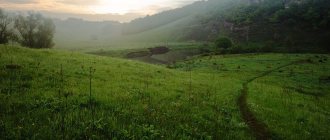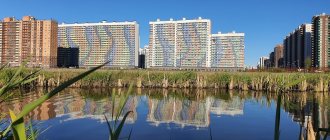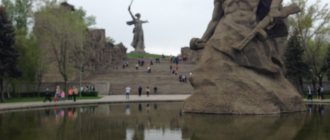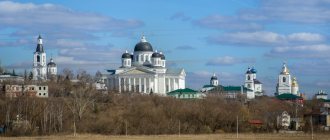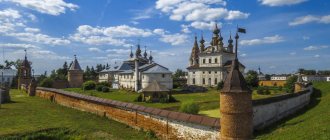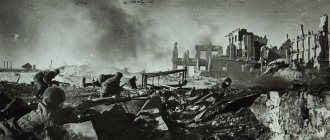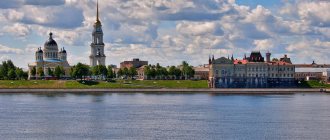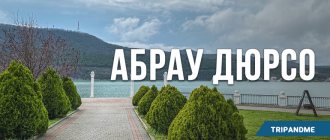In addition to the natural resources of the Volga and the Zhiguli Mountains, the beauty of Samara has another trump card hidden up its sleeve - the unique architectural mosaic of its historical center. But have all its elements been studied in detail and comprehensively? Unfortunately no. We dedicate our material to houses that certainly catch the eye, but are in no hurry to share their history.
The article will be an ideological continuation of the “On Style” column, while working on which we were faced with an almost complete lack of information about very noticeable architectural monuments, such as Volkov’s house on Chapaevskaya or Maslovsky’s mansion on Ulyanovskaya.
To try to find out the history of the buildings we have chosen, we will use the World Wide Web and the book “Architectural Encyclopedia of the Provincial City of Samara.”
Mansion E.G. Erna
Years of construction: 1900-1902.
Architect: Shcherbachev A.A. Address: Chapaevskaya, 165 Perhaps Erna's mansion is the first building in the Art Nouveau style in Samara. The decor of the building is restrained, however, the architect skillfully works with volumes and silhouettes. The graceful curve of the pediment line gives the building a modern rhythm. The only decorative element - the bas-relief of an eagle on the bay window - was destroyed during the Soviet years.
The building turned out to be quite large, in which Dr. Ern lived with his family, received patients, and rented out part of the house as apartments and doctors’ offices. During the Great Patriotic War, the building housed the Polish Embassy. On December 4, 1941, the People's Commissar for Foreign Affairs of the USSR V.M. Molotov and the chairman of the Polish government in exile V. Sikorsky here, already in a tense atmosphere, overshadowed by information about the disappearance of 15 thousand Polish officers near Katyn, signed the Declaration “On Achieving a Lasting and Just Peace.”
What tourists can see
Traveling to Samara can be very exciting if you carefully plan your route and identify the most interesting objects in advance.
Architecture and historical places of the city
The city has a large number of buildings with beautiful architecture and rich history. Even if the trip is for work and does not involve sightseeing, it is still worth carving out some time and visiting one of the following objects:
- Zhigulevsky brewery, which is one of the oldest in Russia. The building was built in 1881. The production was founded by the Austrian Alfred von Vacano. The produced drinks have become popular throughout the country. Tourists can see the object at the address: Volzhsky Prospekt, 4;
Zhigulevsky brewery is located on the river bank - The Catholic Church of the Sacred Heart of Jesus was created in 1906. The attraction is made of red brick in the neo-Gothic architectural style. The beautiful towers reach a height of 47 m. The altar contains the relics of St. Martin de Porres. This place is popular among believers, and tourists will be amazed by its unusual architecture. The cathedral is located at the address: st. Frunze, 157;
The Temple of the Sacred Heart of Jesus features majestic architecture - The building of the Russian Commercial and Industrial Bank is a beautiful structure erected in 1900. Now the object is an architectural monument and one of the popular attractions of Samara;
The building of the Russian Commercial and Industrial Bank has a century-old history and is located near the city center - the mansion of Alexandra Kurlina, a Samara merchant's wife, is located at the intersection of Krasnoarmeyskaya and Frunze streets. The building in Art Nouveau style, erected according to the design of A. U. Zelenko, is an architectural monument. The facade is decorated with shiny blue tiles, which makes the structure beautiful. Now there is a Museum of Art Nouveau, the exhibition of which is presented in three halls;
Kurlina's mansion is notable for its beautiful façade decoration - The Intercession Cathedral is visible from afar, as it has a high tower with a golden dome. The temple was built in 1861 and decorated in the style of Moscow temple architecture of the 17th century. Initially, the inside of the altar was decorated with artificial marble, which in the 19th century was valued higher than natural material. The Orthodox institution is located in the city center, at the address: st. Leninskaya, 75a;
The Intercession Cathedral with bright domes is visible even from the outskirts of the city - The House with Elephants is a dacha that belonged to the Samara merchant and artist Konstantin Golovkin. The house was built in 1909. The Art Nouveau architectural style in which the building is constructed is distinguished by its originality. There are sculptures of elephants in front of the massive gray building. In addition to them, there are other sculptures located in the area adjacent to the dacha. You can look at the unusual building at the address: st. Soviet Army, 292. It’s easy to get here by minibuses No. 246, 89 to the “NFS” stop;
House with Elephants - an object with an unusual architectural design - The St. Sophia Church, built in 1898, is a beautiful and colorful building in the pseudo-Russian architectural style. White patterns, red walls, golden domes make this object one of the remarkable ones in Samara. The church is located on Chapaevskaya street, 136;
St. Sophia Temple is known as one of the most beautiful churches in Samara - The Samara Arena stadium is a large sports facility, the construction of which was completed in April 2021. The building has a rounded roof and is distinguished by its spectacular design. The height of the building is 60 m. The sports complex was built to host matches as part of the 2021 FIFA World Cup. Stadium address: Democratic street, 57;
Samara Arena was built specifically to host matches of the 2021 FIFA World Cup - The symbol of Samara is the Ladya stele, installed on the banks of the Volga in the 1980s. The landmark is located on Oktyabrskaya Embankment, next to the houses of an elite residential complex. You can climb up the boat and look at the surroundings or take a photo next to the monument. The beautiful snow-white building is a popular tourist attraction.
The Ladya stele adorns the city embankment
Military sights of Samara
The city of labor and military glory has several objects that reflect the events that took place here during the Great Patriotic War, the October Revolution and other significant periods:
- Stalin's bunker is the reserve location of the headquarters of the Supreme Commander-in-Chief of the Armed Forces of the USSR I.V. Stalin. The facility was built in 1942. It is located at a depth of 37 m. The location of the bunker was declassified only in 1990. It is located under the building of the Academy of Culture and Arts at the address: st. Frunze, 167. Inside the shelter, the original furnishings, an office and several interesting exhibits have been preserved. Now there is an exhibition dedicated to the Great Patriotic War. You can check the opening hours and cost of visiting on the institution’s website;
Stalin's bunker has preserved its furnishings and presented interesting exhibits. - Glory Square is a popular place for walking. It is here that there is a beautiful and majestic monument that bears the same name as the square. It was opened in 1971. The object is a pedestal 40 m high, on which is installed a figure of a worker 13 m high. The monument is made of high-alloy steel and shines brightly in the sun;
Glory Square and the monument of the same name are located near the city center - On Chapaev Square you can see a monument dedicated to this national hero. The sculpture is a complex composition depicting a horseman and soldiers going into battle. The monument was erected in 1932 according to the design of the sculptor M. G. Manizer. The monument is made of bronze: in total, about 12 tons were required;
The monument to Chapaev is located on the square of the same name - The monument to minor home front workers was opened in 1996 and is dedicated to children who made a great contribution to the victory during the Great Patriotic War. A monument in the form of figures of a boy and a girl sitting on a bench can be seen at the intersection of Osipenko and Novo-Sadovaya streets in the Oktyabrsky district of Samara.
The monument is dedicated to children home front workers who worked during the Great Patriotic War
Museums and cultural sites
The cultural heritage of past centuries in Samara is diverse. There are many museums, theaters and other places that will be of interest to tourists:
- The Samara Regional Art Museum, opened in 1897, presents to visitors the works of Samara masters of the 19th and 20th centuries, as well as a collection of graphics and Russian painting. The collection of works of the Russian avant-garde of the early 20th century is considered interesting. The institution is located at: st. Kuibysheva, 92. The museum is open daily from 10.00 to 18.00, closed on Tuesday. You can find out more detailed information and the cost of excursions on the official website;
The Samara Art Museum displays many works of painting and other forms of art. - The Samara Drama Theater named after M. Gorky is known as the oldest drama theater in Russia. It was founded in 1851, but now performances are held in a building built in 1888 and which is an object of cultural heritage of the peoples of Russia. Famous actors and honored artists take part in many performances. You can visit the theater at the address: pl. Chapaeva, 1;
The Samara Drama Theater puts on interesting performances with the participation of famous artists - The Art Nouveau Museum can be visited in the Kurlina mansion. Art Nouveau interiors are recreated on the ground floor, while temporary art exhibitions are often held on the second floor. Children under 16 years of age can view the main exhibition for free, and the ticket price for other categories of citizens and the opening hours should be clarified on the institution’s website. Museum address: st. Frunze, 159/Krasnoarmeyskaya 15 (corner building). The entrance is located from Krasnoarmeyskaya Street. Nearby is the Frunze stop, which is served by bus 34 and trams No. 3, 15, 16, 20, as well as minibuses 92, 207, 226, 240;
The original interiors of the premises have been restored in the Art Nouveau Museum - The Samara State Philharmonic was founded in 1940. Concerts and music lectures are held here. The film “Life and Fate” was filmed in the building. The building is distinguished by elegant architecture; there is a sculptural composition on the roof above the entrance, and the walls are decorated with bas-reliefs. Philharmonic address: st. Frunze, 141.
The Philharmonic in Samara is a major cultural institution
Where you can go for a walk in Samara
Samara is a city with an interesting cultural heritage and rich history, as well as one of the most picturesque settlements in the country. Tourists should visit places such as:
- Strukovsky Garden is one of the oldest parks in Samara. It is located next to the Samara Drama Theater. The garden was founded in 1851, and before that the estate of one of the city’s state councilors was located here. Nowadays the Flower Festival and other cultural events are held here annually;
Strukovsky Garden is a popular venue for cultural and entertainment events - Tsarev Kurgan is a hill located near the village of Volzhsky, 40 km from the city. The hill has a flattened top, on which a 15 m high worship cross is located. The Church of the Nativity of Christ was built next to the hill;
Tsarev Kurgan is located in a picturesque area near Samara - Samara embankment is one of the most beautiful places in the city. From here you have an impressive view of the river. This place is popular for walking, there are many flower beds and fountains, and there are benches for relaxing. Cultural events are often held on the embankment.
The Samara embankment is a landscaped recreation area
Excursions and attractions in different seasons
In summer there is no sweltering heat in the city: the average air temperature is +25 °C. At this time of year, you can walk along the embankment and the city center, but a trip to the Mastryukovsky Lakes will bring special pleasure. This regional natural monument covers an area of 321.29 hectares and is located along the banks of the Volga near the Mastryukovo and Zadelnaya stations. Travelers can see lakes and springs on the way from Tolyatti to Samara. To do this, you need to turn off the Samara - Togliatti highway towards the village of Kurumoch, and then along the street. School ride by car to the bank of the Volga.
Mastryukovsky lakes are popular for fishing and water sports
At the beginning of autumn it is still warm in the Samara region, but in October the rains become more frequent and cloudy weather can ruin long excursions around the city and its environs. At this time it is worth visiting the Samara Football Museum. It was opened in 2007 in a small room at the address: st. Molodogvardeyskaya, 148. Here you can see awards, sports attributes, photographs and much more that is associated with the Samara club “Wings of the Soviets”. You can get here by trams No. 15, 20, 20K, 5, by buses No. 37, 47 and by minibuses No. 37, 47, 46, 295 to the stop “Ul. Molodogvardeyskaya". Information about the cost of excursions and work schedule is presented on the institution’s website.
In the football museum, exhibitions are dedicated to the Wings of the Soviets club.
The average air temperature in Samara in winter is about -20 °C. On New Year's holidays, the main place for folk festivities is the square named after. V.V. Kuibysheva. On non-holiday days you can visit the museum-estate of Alexei Tolstoy. Thanks to the surviving documents, letters and other materials in the premises, it was possible to restore the interiors of 1900. In addition, in the museum, visitors can see some of the writer’s things and learn a lot about his work.
Address: Frunze street, 155.
Opening hours: Mon-Wed from 10:00 to 18:00, Thu from 12:00 to 20:00, Fri-Sun from 10:00 to 18:00. The cost of visiting and other information can be clarified by calling: +7(846)332‑11–22.
The literary museum features exhibitions dedicated to the life and work of A. Tolstoy
In mid and late spring, you can go for walks and excursions around the city, as the street gradually gets warmer and the likelihood of precipitation decreases. During one of the walks, it is worth looking at the sculptural composition “Barge Haulers on the Volga”. It was installed in 2014 on the Samara embankment. The sculpture is based on the painting of the same name by I. Repin, the author of the monument is N. Kuklev.
The sculpture “Barge Haulers on the Volga” is based on the painting of the same name by I. Repin
A trip to Samara will be comfortable at any time of the year, but before traveling you should take into account the weather conditions and choose comfortable clothes and shoes.
Best places for kids
Tourists who come to Samara with a child can visit several interesting places:
- The Children's Art Gallery is an unusual cultural institution where works by artists on the themes of legends and fairy tales are presented, and in the summer the exhibition “Exclusive Dolls of the Klodt Mansion” is held. The museum hosts workshops for the development of children's creativity and lecture halls. Attraction address: Kuibysheva Street, 139 (mansion of the merchant Ivan Andreevich Te-Klodt). The institution is open from 9:00 to 18:00, seven days a week. An adult ticket costs 100 RUB, and children under 7 years old can see the exhibition for free. It is worth considering that free admission for everyone is possible on the first Monday of every month;
A children's art gallery allows you to introduce your child to the world of art - The Zoological Museum named after D. N. Florov is one of the oldest museums of this type in the Volga region. In 4 halls there are maps of the habitats of various animals, display cases with tropical butterflies, a model of a 14-meter squid, stuffed animals and much more. It is located at the address: st. Antonova-Ovseenko, 24. A ticket for adults costs 100 RUB, and there is a free visiting program for children. You can check the opening hours on the museum’s website;
The exhibitions of the Zoological Museum allow you to learn a lot about the animal world. - The museum “Motorworld of Vyacheslav Sheyanov” presents a large number of tricycles and motorcycles to visitors. Equipment from 14 countries around the world has been restored to perfect condition. Here you can organize a cross-country trip under the supervision of an experienced instructor. Address: Petra-Dubrava village, st. Klimova, 2B. The museum hosts themed excursions for tourist groups. You can find out the cost of a particular event on the institution’s website;
The Museum "Motorworld of Vyacheslav Sheyanov" presents to the attention of visitors motorcycles of different years of production - Samara Zoo was founded in 1992. The area of 0.23 hectares is home to 1,727 animals. Comfortable conditions for relaxation and excursions have been created here. The institution is located on the street. Novo-Sadovaya, 146. Opening hours, ticket prices and other information can be found on the zoo’s website.
You can relax in comfort at the Samara Zoo
The city has many cafes and shops that will not let you get hungry during a long walk and sightseeing. Public transport runs regularly, but cycling can be a fun activity for the whole family.
What to see during a short trip to Samara
If your stay in the city lasts no more than 1 day, then you can limit yourself to a walk along Lenin Avenue. There is a museum and exhibition here, which was opened in 2007. There is a real Soyuz launch vehicle installed outside, and the museum building displays exhibits, models of spaceships, instruments, photographs and much more. The gift shop sells pins, flash drives and other space-themed memorabilia.
Museum address: Lenina Ave., 21. You can get here by metro to Rossiyskaya station, as well as by trams No. 4, 5, 18, 20, 22, 23. Trolleybus No. 19 and buses No. 2, 23, 25, 47 , 50 and 61 run to the metro station. Full information about the opening hours and ticket prices is available on the museum’s website.
In the Museum and Exhibition you can see space instruments and equipment
A holiday in Samara can last several days. Before your trip, you should book a hotel room or rent an apartment.
During 5–7 days of rest in Samara, tourists can implement a rich cultural program. Excursions to the house with elephants, visits to the Samara Football Museum or the museum-estate of Alexei Tolstoy, the Strukovsky Garden and the Samara Art Museum will allow you to learn a lot of interesting things about the city. In the evening it is worth taking a walk along the embankment. Not far from the CSKA VVS swimming pool there are singing fountains equipped with multi-colored lighting. Address: Volzhsky pr., 10. You can admire the fountains from May to October from 21:00 to 23:00.
Fountains with multi-colored lighting decorate the embankment in Samara
A walk along Khlebnaya Square, located in the city center at the intersection of Razin and Kutyakova streets, will diversify your holiday. Here you can see three beautiful churches. If you stay in Samara for a long time, it is worth making a trip to the Mastryukovsky Lakes.
Trading house S.E. Permyakova (Trading house A.N. Permyakova)
Years of construction: 1900-1901.
Architect: Zelenko A.U. Address: Molodogvardeyskaya, 70 The first building of Zelenko in the Art Nouveau style in Samara. Four wide pylons divide the facade into three parts: a central, narrower one, and wide side ones. The trunks of the pylons are decorated with large female masks entwined with waves of flowing hair, into which shells and water lilies are woven. Perhaps Zelenko portrayed the customer Permyakova herself here.
House of Zabrodins
(Leninskaya, 103)
Name in OKN: “House of the Zabrodins” Date of construction: late XIX - early XX centuries Architect: unknown
Pre-revolutionary photos: none
Information from the network: a house similar in architecture was located near the intersection of Chapaevskaya and Vilonovskaya. Source Information from the book: the Zabrodins’ house. Built in 1890 in Scandinavian Art Nouveau style.
On the right is the Zabrodins’ house in the 1970s. Find more photographs of Kuibyshev from that period here.
Results: the house itself was probably built in 1890, and acquired its current façade and remarkable stepped gable later. Who the gentlemen Zabrodins were, what class they belonged to, history is silent. Likewise, the name of the architect who managed to incorporate elements of northern Art Nouveau into the bourgeois development of the then Sokolnichya Street remains unknown.
Mansion A.U. Zelenko
Years of construction: 1900-1903.
Architect: Zelenko A.U. Address: Samarskaya, 179 In 1900, architect A.U. Zelenko received permission to build his own house. The construction of the mansion was completed in 1903, but Zelenko did not live a single day in it, since in 1900 he left for Moscow at the invitation of F.O. Shekhtel. The building is designed in Art Nouveau style with windows of different sizes and an asymmetrical façade. The massiveness of the walls is contrasted with the lightness of the balcony grille and metal brackets. The corner of the balcony is supported by one large limestone column. Currently, the building houses the House of Journalists and Writers.
Apartment house A.F. Nuycheva (Gymnasium of the Kharitonov Sisters)
Years of construction: 1902-1904.
Architect: Kvyatkovsky M.I. Address: Samarskaya, 149 Apartment building A.F. Nuycheva became the first Samara building of M.I. Kvyatkovsky. A noticeable detail of this house is the zoomorphic ornament. These are butterflies - a symbol of the fragility and fragility of existence, and the heads of elephants supporting the bay window. The decor also includes women's masks - a symbol of eternal beauty and Atlantean figures (removed in the 1980s for restoration). The elegant forged elements in the fencing of the balconies and the canopy over the entrance also deserve attention. For a long time, this building housed the Kharitonov sisters’ gymnasium, and after the revolution, school No. 25 and a lyceum.
Kozhevnikov House
This house was built in the late 90s of the 19th century. The decor of the building is very elegant, in the best traditions of Russian architecture. On the blades of the building you can find symbols of the sun and floral patterns. On the facade you can find the initials of the owner of the building, Andrei Frolovich Kozhevnikov - “A.F.K.”
The house has another interesting element - a clock carved from wood. It is believed that the merchant Kozhevnikov placed this clock on the facade of the house in memory of one of his daughters, who died under mysterious circumstances.
The house was painted for the World Cup At the moment, there is a threat of demolition of this house, since the local authorities have not recognized the house as a cultural heritage site.
Pushkin People's House
Year of construction: 1903. Architect: Zasukhin F.P.
Address: L. Tostogo, 94 Public buildings were rarely built in the Art Nouveau style, but there were exceptions. One of the first public buildings in the Art Nouveau style in Samara was the Pushkin People's House. This building is characterized by minimalist facade decoration, large details, metal decorations on the gates and porch in the spirit of European Art Nouveau. Inside there was another grand staircase and the entrance to a theater hall with 775 seats. On the second floor there are several rooms for classes, and in the one-story part, to the left of the main entrance along the street. L. Tolstoy, there was a library with a reading room and a tea room. Now the building houses the Palace of Culture of Railway Workers named after. A.S. Pushkin.
Subbotin-Markison Mansion
(Alexey Tolstoy, 30)
Date of construction: ∼ 1911-1912 Architect: Mikhail Kvyatkovsky
Gothic in Samara is not only a place of worship, but also apartment buildings. The history of this handsome man from Kazanskaya Street had everything that we love pre-revolutionary buildings for - a radical reconstruction of the building by a talented architect with money from an influential merchant family and a Masonic tenant.
“Gothic motifs are especially clearly visible on the top floor of the building with high turrets and vials with pointed pyramids at the corners, as well as at the bay window and the center of the end facade. Gothic details are fused with Art Nouveau decorative techniques in the entrance part of the building and with the colored ceramic decoration of the plastered façade. The architecture of the house is a clear example of the interpretation of the Gothic style in the interpretation of the appearance of an apartment building in the Art Nouveau era.”
For its services in decorating the architectural appearance of Samara, the Subbotin-Markinson mansion was awarded a separate article by DG.
Mansion A.P. Kurlina
Years of construction: 1900-1904.
Architect: Zelenko A.U. Address: Frunze, 159 Mansion of the merchant of the 1st guild A.G. Kurlin and his wife A.P. Kurlina became one of the first buildings in Samara in the Art Nouveau style. The mansion was decorated with the street. Saratovskaya (now Frunze Street) with its facade with a front door decorated with mirror glass and curls of black metal. According to legend, the mysterious profile of a woman’s head on the pediment resembles the mistress of the mansion herself. On the street Alekseevskaya (now Krasnoarmeyskaya Street) house attracted the eye with its openwork butterfly gate, balcony and large dragonfly made of forged metal on the roof.
In 1995, the mansion became a monument of historical and cultural heritage of federal significance. Since 2012, the Modern Museum was opened in Kurlina’s house.
Mansion P.I. Shikhobalova
Years of construction: 1903-1905.
Architect: Shcherbachev A.A. Address: Ventseka, 55 Built by a wealthy representative of the young Samara bourgeoisie - P.I. Shikhobalov. In the development of the project, in addition to A.A. Shcherbachev was attended by Samara architect G.N. Moshkov. Only the façade of the main building faces Ventsek Street, which is decorated with pediments and flowerpots in the upper part. The windows are rectangular in shape, on the ground floor they are larger in size, here the typical thrust of Art Nouveau towards large areas of glazing is manifested. The balcony above the arch was supported by atlases, which for a long time were the hallmark of the house, but in 1993 they were removed for restoration. During the Soviet years, the building was occupied by the NKVD, and then by a military tribunal.
Temple of the Sacred Heart of Jesus
(Frunze, 157a)
Date of construction: 1906 Architect: project - Foma Bogdanovich, supervision of construction work - Alexander Shcherbachev
The quintessence of the Gothic style in the architecture of Samara and, together with the modern Kurlina mansion and the constructivist Radio House, is one of the most “postcard” views of the city. Construction of the church began in 1902 and cost 80,000 rubles.
“Gothic, or rather the passion for Gothic, is developing as an independent architectural movement in line with the general stylistic searches characteristic of the turn of the 19th-20th centuries.
The main entrance is a series of pointed arches, located one after another and recessed into a brick wall <…> A white twisted column with a capital rises above the entrance. Like a spring, it enhances the upward tendency and emphasizes the axis of symmetry.
The façade is flanked by slender, tall towers. They are integral to the image of a Gothic cathedral. <…> Frozen calm is alien to the Gothic. Her style is soaring, vertical. Horizontal development is kept to a minimum. The faceted pilasters of the turrets end with pointed helmets.”
In January 1930, a Polish-German club was opened in the church. And its longest “tenant” during the Soviet period was the local history museum, which was located here from 1941 to 1991, after which the temple was returned to believers.
It wouldn’t be a bad idea to look into the church courtyard. There you will find a two-story chapel - a Catholic prayer house built back in 1887. Before the church was built, services were held there, and a priest lived on the second floor.
Restaurant "Aquarium"
Years built: 1900s.
Architect: Kvyatkovsky M.I. Address: Samarskaya, 95 This building is a manifesto of strict and rational modernity. Its peculiarity is the layout of laconic, strict, multi-storey volumes placed on a high base. The bay window of the central volume was crowned with a single decorative element - a metal structure imitating a dome. The expression of the Art Nouveau style here is not ornamentation, but smooth curved lines growing out of the plane of the wall, the multi-volume nature and rhythm of the building. The Aquarium restaurant belonged to the famous Ivanov brothers in Samara and was famous for its gypsy choir. After 1917 the building was nationalized. In Soviet times, the Theater of Young Spectators was located here.
Photo gallery: maps of some areas
Stalin's bunker is located near the city center
Country park is in demand for recreation
The zoo in Samara is located in a green area
"Ladya" can be seen on the Samara embankment
The city has many parks with attractions and recreation areas
Khlebnaya Square is located in the center of Samara
Theater-circus "Olympus"
Year of construction: 1907. Architect: Shamansky P.V.
Address: Frunze, 141 Now on the site of “Olympus” stands the Samara Philharmonic. In the 1980s The old building was demolished due to its unsafe condition, and a new one was built in its place. The author of the project was Yu.V. Temples He took the appearance of the old building as a basis, moved it 15 meters from the red line, and added usable space. The original building was decorated with Art Nouveau elements: women's heads, bas-reliefs of winged pegasuses, sculptures of characters from Greek mythology, balconies with openwork lattice and curved windows and doors. Most of the decorative elements of the Olympus Circus were copied by Yu. Khramov and transferred to the facade of the new building.
Museum "Cosmic Samara"
Museum "Cosmic Samara". Photo: FotograFF / photobank “Lori”
The Samara Space Museum and Exhibition Complex was opened in 2001 in honor of the 45th anniversary of Samara space engineering.
The original Soyuz rocket was installed on the façade of the building. Its height is more than 53 meters, and its weight is 20 tons. The Soyuz rocket has traveled into space 1,881 times. The same launch vehicle was installed as a monument near the Rossiyskaya metro station in honor of the anniversary of Yuri Gagarin’s flight in 2001.
Mansion V.M. Suroshnikova
Year of construction: 1907 (?).
Architect: Shcherbachev A.A. (Shekhtel F.O.). Address: Tolstoy, 41 The history of the construction of this mansion is shrouded in mystery. Its author has always been considered A.A. Shcherbachev (as his friend K.P. Golovkin claimed), however, archival research by art historians suggests that the author of the original project was the famous Moscow architect Fyodor Shekhtel. The architecture of Suroshnikov’s house shows a clear influence of strict “northern modernism”. A varied range of finishing materials, characteristic of Art Nouveau, is used: natural stone, blue tiles, grained plaster. The corner balcony is reminiscent of the balcony of the right tower of the Yaroslavsky railway station in Moscow, designed by F.O. Shekhtel.
Serebryannikova's mansion
(Stepan Razin, 41)
Date of construction: 1904 Architect: Alexander Shcherbachev
Interestingly, the house was originally one-story and, like Belousov’s mansion, had minarets. Alexander Shcherbachev uses the same architectural elements here, for example, columns with capitals of the composite order. Now the mansion is occupied (at least since the 1960s) by a medical institution, and before that there was an archive of the party history of the regional committee of the CPSU.
Dacha K.P. Golovkina
Years of construction: 1908-1909.
Architect: Golovkin K.P., Tepfer V.V. Address: Soviet Army, 298 Konstantin Golovkin was a merchant, artist, archaeologist, philanthropist, traveler, member of the City Duma and self-taught architect. He, together with his friend Valentin Tepfer, designed a building that to this day remains the most mysterious building in Samara. The dacha is located on the slope of a hill. From the Volga, 3 volumes are clearly visible, cut through by narrow windows. In front of the entrance to the building there is a sculpture of a girl emerging from the Volga wave, and in front of the facade there are two elephants mounted on a retaining wall made of stone. Thanks to these stone animals, the popular name “Dacha with Elephants” was assigned to Golovkin’s dacha.
Travel tips
The city has certain rules and traditions. Tourists should take into account the following features:
- Car traffic is prohibited on Leningradskaya Street: there is a pedestrian zone with a large number of historical attractions;
- the main bicycle path runs along the embankment of the Volga River;
- You can purchase tickets for a river cruise at travel agencies. During the trip, tourists will visit nearby cities and get acquainted with the culture of the region;
- Non-cash payments are possible in large stores and restaurants, and in the market you can purchase products for cash.
Warehouses N.V. Meshkova
Year of construction: 1909. Architect: unknown.
Address: M. Gorkogo, 98 Meshkov's warehouses are an example of an industrial and warehouse complex built in the Art Nouveau style. Samara at the beginning of the twentieth century. was a rapidly growing city. There was a need for storage and sale of large quantities of building materials. It was for this purpose that the merchant Meshkov built this complex. The design actively used the latest material for that time - reinforced concrete. Thanks to it, the silhouette of the main facade resembles a river wave and is in harmony with the opening view of the Volga expanses. Unfortunately, the author of the project is not known, but it is known for sure that the construction was carried out by a St. Petersburg company specializing in reinforced concrete buildings.
half-timbered house
(Frunze, 75)
Date of construction: ∼ 1904-1912 Architect: unknown
A piece of northern Europe on the former Saratovskaya. A house was built for the famous Samara lawyer Osip Girshfeld. He also owned a stone house facing Frunze Street.
“This is a half-timbered building. The essence of its architecture lies in the enclosing structures of the frame from a system of horizontal, vertical and inclined wooden beams (framework). The gaps between the walls divided by beams are filled with bricks. The pointed gable, gable roof, cone-shaped end of the corner tower, bay windows supported by wooden consoles, combined with a number of modernist elements, give the building features of the “Gothic” architecture of northern Germany.”
For its services in decorating the architectural appearance of Samara, the half-timbered house also received a separate article from DG.
Novokreshchenova's mansion
Year of construction: 1909. Architect: Kvyatkovsky M.I.
Address: Frunze, 144 This mansion is an example of sophisticated elite modernism. The decoration of the façade is dominated by floral motifs - these are orchids, which with their long curved stems entwine the building and, rushing upward, bloom on its cornice. A sophisticated viewer will immediately note that these orchids are very similar to those that decorate the Bristol-Zhiguli Hotel. Flowers are a kind of “calling card” of the architect Kvyatkovsky, whose surname, by the way, is derived from the Polish word “kvyat” - flower.
Apartment building P.P. Golovkina
Year of construction: 1910. Architect: P.P. Golovkin.
Address: Leningradskaya, 22 The architect of the building was the owner of the house himself, the younger brother of Konstantin Golovkin, Peter. He received his art education in Moscow. This building contains recognizable elements of the Art Nouveau style. This includes bold work with ornaments, a choice of decorative materials, an abundance of volumes, bas-reliefs with women’s heads, and forged balcony railings. However, the symmetrical facade of the building is rather atypical for Art Nouveau. The owner spent 19,000 rubles on building the house, which was a fabulous sum at that time. Most of these funds went to furnishing the interiors. Most likely, part of the internal space was rented out for shops.
St. George's Lutheran Church
(Kuibysheva, 115-117)
Date of construction: 1865 Architect: designed by engineer Nikolai Eremeev, it was redesigned by architects from St. Petersburg
Initially, the church building was built for the Catholic community of the city. The main “instigator” in this case was the Samara merchant Yegor Annaev. When the temple was almost ready by 1864, an uprising occurred in Catholic Poland, which was part of the Russian Empire at that time. As a result, with the consent of Yegor Annaev, the building was transferred to the Lutheran community of the city.
“This is the main dominant feature of the main street. Without this vertical, the church bell tower, the street perspective would be hopelessly monotonous.”
The church building was illuminated on September 26, 1865. 12 years later it was practically destroyed by a huge fire. It took 6 years to restore the church. But every cloud has a silver lining, and it was then that she acquired side wings.
Like the church, the church was closed in January 1930. However, she had a much longer list of “tenants”. Starting from the “Union of Militant Atheists” of the 1930s, ending with the workshop of monumental sculptors. In the first list of historical and cultural monuments in 1966, it was listed as “Workshop of the Union of Artists. Gothic".
On December 21, 1991, in the church, despite the fact that restoration and repair work had not yet been completed and the heating was not working, the first Christmas service was held after a 60-year break.
Hotel "Bristol-Zhiguli"
Years of construction: 1870-1879;
Reconstruction: 1911. Architect: Kvyatkovsky M.I. Address: Kuibysheva, 111 The building in the classicist style with a symmetrical, strict facade was built in 1879. A few years later, the hotel of the Ivanov brothers was opened in it, which existed until 1907. Then the house was occupied by another, even more luxurious hotel - the Grand Hotel " Especially for its opening M.I. Kwiatkovsky reconstructed the building in the Art Nouveau style. The architect turned to the idea of ornamentation, and this is where his “signature” floral decor is born. Orchids decorated not only the facade, but also the interiors of the building.
Kwiatkowski worked actively with form, giving the three balconies on the second floor a natural, streamlined look. During the Civil War, the headquarters of the Samara Rifle Division was located here, and during the Great Patriotic War, the representative office of the Committee for the National Salvation of France was located here.
Trading house Shchetinkina P.V.
Year of construction: 1914, reconstruction: 1932. Architect: Ushakov-Reshetnikov Ya.S.
Address: Molodogvardeyskaya, 67 In 1876, Kazan merchant Pavel Vasilyevich Shchetinkin opened a branch of his partnership “P.V. Shchetinkin in Kazan" for the sale of haberdashery goods and furs in Samara. At first he rented premises in apartment buildings, but in 1913 he began construction of a personal building for a trading house on the corner of Sobornaya and Predtechenskaya streets. The construction, which was completed in 1914, was headed by the self-taught architect Yakov Stepanovich Ushakov-Reshetnikov. In 1932, the building was added three floors by architect S.K. Efremov.
The building has a symmetrical composition with alternating volumes of different heights. The rhythmic pattern of the facades is determined by the alternation of wide showcases, window openings and narrow openings covered with hog tiles. The center of the building’s composition is a two-story corner bay window, which before reconstruction was topped with a hipped roof.
Public meeting building
Year of construction: 1914. Architect: Werner D.A.
Address: Kuibysheva, 157 In 1911, the Public Meeting of government officials and public organizations decided to build their own building with the goal of “providing its members and their families with the opportunity to spend time with convenience, benefit and pleasure.” Balls, masquerades, literary evenings, dramatic performances, scientific lectures were held here, and there was a library.
The three-facade building was designed and built by Dmitry Aleksandrovich Werner. All three facades are unique and do not repeat each other in any way. The central window of the facade from Kuibyshev Street is decorated with a male mask, whose hair flows in smooth lines onto the neighboring windows. Above the central entrance group there is a uniquely shaped dome, which was previously decorated with stained glass.
House of Lineva-Rozina
(Kuibysheva, 44)
Date of construction: 1901 Architect: Filaret Zasukhin
The intersection of Pionerskaya and Kuibyshev streets attracts attention with the presence of two beautiful buildings that pleasantly complement each other. Along the odd side of the pre-revolutionary Dvoryanskaya Street stretches the Samara “office” of the Russian Commercial and Industrial Bank. At the turn of the 19th and 20th centuries, its façade acquired a modern look. The famous architect Alexander Zelenko transformed the standard project into an example of the “Old French” style.
Their neighbors on the even side decided to keep up and ordered the reconstruction of their two-story house in the “German” style (as Gothic was called in pre-revolutionary Samara). The author of the reconstruction was the famous Samara architect Filaret Zasukhin.
Mansion N.S. Zhogoleva
Years of construction: 1910s.
Architect: Moshkov G.N. Address: Galaktionovskaya, 57 The only Art Nouveau building in Samara, in which the influence of Baroque can be traced. The building seems rather squat, which is largely due to the architect’s rejection of the typical Art Nouveau “showcase windows.” Art Nouveau here reveals the asymmetrical façade, an abundance of smooth curves and women's heads in the ornament. Once upon a time, the bay window on the right side of the building, forming the second corner facade, was crowned with a dome, similar to the dome above the entrance projection.
Gothic and Moorish style
Years of existence of styles in Russia: ∼ end of the 18th century - 1910s (Gothic), ∼ mid-19th century - 1910s (Moorish style).
In Samara, these two styles were used primarily in the construction of religious buildings. The number of mansions and apartment buildings is relatively small, and therefore each of them only becomes more valuable. It is worth noting that the Moorish style was widely used in the architecture of country houses of Samara merchants. However, numerous reconstructions carried out during the Soviet period often leave no trace of it, and some buildings have not survived at all.
Note: when preparing the material, the books by Vahan Karkaryan “Modernism in the architecture of Samara” and “Samara-Kuibyshev-Samara, or Three portraits of one city” were used. Excerpts taken from there are in italics.
Cinema "Furor"
Years of reconstruction: 1914. Architect: Kotov G.I.
Address: Sadovaya, 231 The building belonged to M.E. Antonov, in 1914 he decided to reconstruct it in the Art Nouveau style. The project was taken up by Muscovite Grigory Ivanovich Kotov. The architect tried to avoid eclecticism and borrowing from past styles and tried to embody pure late modernism in his construction. However, the building is richly decorated with stucco decoration. His calling card was the green “boar” - a facing tile that was very popular in Samara buildings at the beginning of the 20th century.

